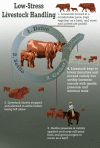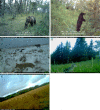Low-stress livestock handling protects cattle in a five-predator habitat
- PMID: 36793893
- PMCID: PMC9924134
- DOI: 10.7717/peerj.14788
Low-stress livestock handling protects cattle in a five-predator habitat
Abstract
Given the ecological importance of top predators, societies are turning to non-lethal methods for coexistence. Coexistence is challenging when livestock graze within wild predator habitats. We report a randomized, controlled experiment to evaluate low-stress livestock handling (L-SLH), a form of range riding, to deter grizzly (brown) bears, gray wolves, cougars, black bears, and coyotes in Southwestern Alberta. The treatment condition was supervision by two newly hired and trained range riders and an experienced L-SLH-practicing range rider. This treatment was compared against a baseline pseudo-control condition of the experienced range rider working alone. Cattle experienced zero injuries or deaths in either condition. We infer that inexperienced range riders trained and supervised by an experienced rider did not raise or lower the risk to cattle. Also, predators did not shift to the cattle herds protected by fewer range riders. We found a correlation suggesting grizzly bears avoided herds visited more frequently by range riders practicing L-SLH. More research is required to compare different forms of range riding. However, pending experimental evaluation of other designs, we recommend use of L-SLH. We discuss the cobenefits of this husbandry method.
Keywords: Carnivores; Human-Carnivore Coexistence; Livestock-Carnivore Conflict; Non-lethal methods; Predator control; Randomized controlled trials.
©2023 Louchouarn and Treves.
Conflict of interest statement
The authors declare there are no competing interests.
Figures




References
-
- Alberta Environment and Parks . Grizzly bear response guide, Report. 1. Vol. 6. Alberta Environment and Parks; Alberta: 2016.
-
- Alberta Environment and Parks Predator Compensation 2015 to 2019: South Saskatchewan Region 2020.
-
- Bangs E, Jimenez M, Niemeyer C, Fontaine J, Collinge M, Krsichke R, Handegard L, Shivik J, Sime C, Nadeau S, Mack C, Smith DW, Asher V, Stone A. Non-lethal and lethal tools to manage wolf-livestock conflict in the Northwestern United States. Proceedings of the 22nd Vertebrate Pest Conference; Davis, CA. 2006. pp. 7–16.
-
- Barnes M. Livestock management for coexistence with large carnivores, healthy land and productive ranches. Keystone Conservation. 2015 https://wolfwatcher.org/wp-content/uploads/2015/09/Livestock-Manangement.... (accessed Jan 24, 2023)
-
- Boronyak L, Jacobs B, Wallach A, McManus J, Stone S, Stevenson S, Smuts B, Zaranek H. Pathways towards coexistence with large carnivores in production systems. Agriculture and Human Values. 2021;9:47–64.
Publication types
MeSH terms
LinkOut - more resources
Full Text Sources

